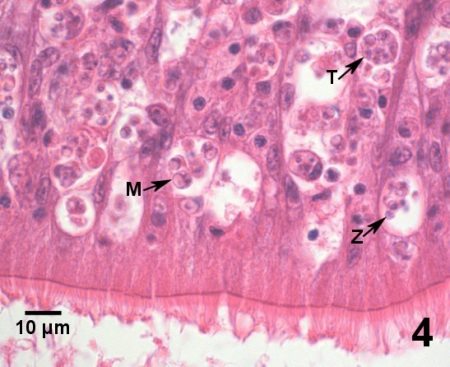
Perkinsus marinus (Mackin, Owen. Malcolm & Collier, 1950, Levine 1978, common name Dermo) was described as Dermocystidium marinum from Barataria Bay Louisiana as a result of studies of Eastern Oyster (Crassostrea virginica) mortality. It was initially classified as a fungus, and later as a protozoan. Currently, it is placed in the Kingdom Chromista, phylum Myzozoa. It is a microbial parasite of the Eastern Oyster, Crassostrea virginica, associated with oyster die-offs. In Chesapeake Bay, Perkinsus marinus was first identified in oyster samples from the Rappahannock River, collected in 1949, during a period of extensive oyster mortality. In estuaries north of Chesapeake Bay, appearances of P. marinus were often associated with oysters transplanted from Chesapeake Bay, appearing in 1955 in Delaware Bay, 1982 in New Jersey coastal bays, 1991 in Raritan Bay, and occurrences from Long Island to Damariscotta Bay, Maine in the 1990s. The range expansion of dermo is believed to be associated both with oyster transplants and climate change. Within Chesapeake Bay, the expansion of the disease in the upper Bay was associated with droughts, while the northward expansion is attributed in part to climate change, and to the evolution and spread of cold-resistant strains. In late November 2024, the Canadian Food Inspection Agency detected P. marinus in oyster samples from Merigomish Nova Scotia and Spence Cove, New Brunswick, the first Canadian and farthest northward detections so far. To the south, it has been found in tropical Mexico in the amphi-American Charru Mussel (Mytella strigata) in the Gulf of California, and from the cultured Pacific Oyster (Magallana gigas), the native Pleasure Oyster (Crassostrea corteziensis), and several other native bivalve species from Tropical Pacific Mexico. This parasite has also been found in introduced Eastern Oysters (Crassostrea virginica) in Pearl Harbor, Hawaii.
Photo Perkinsus marinus in histological sections of the connective tissue in the digestive gland intestinal epithelium (Fig. 4) of Crassostrea virginica from Maryland, USA. Haematoxylin and eosin stain.https://www.dfo-mpo.gc.ca/science/aah-saa/diseases-maladies/pmdoy-eng.html